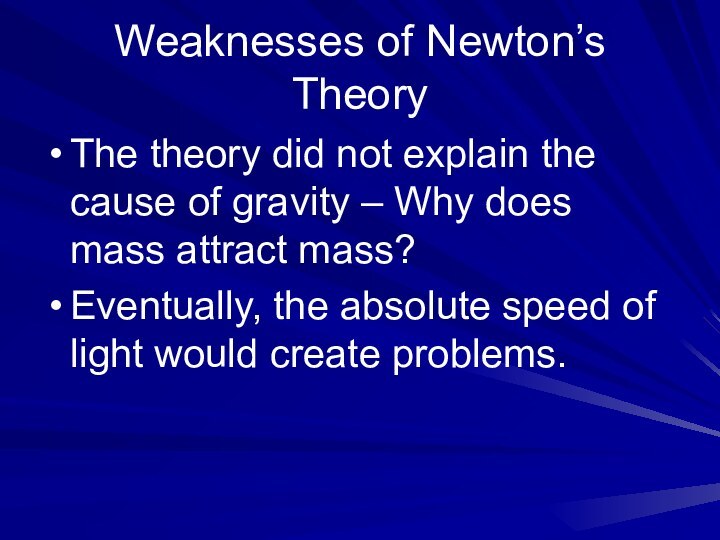Слайд 2
Isaac Newton 1642-1727
Considered one of the greatest intellects
that ever lived
Newton had a difficult childhood and was
considered an odd boy.
He was sent to Cambridge in 1660 to earn a degree in law.
Слайд 3
During this time, a mostly Plato/Aristotle view of
universe predominated.
Newton sought truth in science and math.
“Plato is
my friend, Aristotle is my friend, but my best friend is truth.”
Слайд 4
Newton returns home
Graduated from Cambridge in 1665 with
no distinction.
The plague closed university that same year.
Newton returned
to his family’s farm for 18 months.
Слайд 5
1666 – Newton’s miracle year
Newton developed a theory
of light (white light is composed of all colors).
He
developed calculus.
Created his laws of motion.
And finally, created his universal theory of gravitation.
Слайд 6
Development of Calculus
He named it the “Method of
Fluxions.”
Used it for finding areas, tangents, the lengths of
curves and the maxima and minima of functions.
Слайд 7
Newton needed this to develop his laws of
motion and law of gravitation.
The credit for calculus is
now shared with Leibniz.
Слайд 8
Newton’s three laws of motion
First Law
An object does
what it’s already doing unless affected by an unbalanced
force.
This is Galileo's concept of inertia.
Also called the “law of inertia”.
Friction is a force.
Слайд 9
This was more advanced than the Plutonian view
of movement.
Слайд 10
Second Law of Motion
F = ma
F = net
(unbalanced) force in Newtons
m = mass in kilograms
a
= acceleration in m/sec2
Слайд 11
He probably used Galileo's experimental conclusions to develop
this equation.
This equation can be developed from lab experiments.
Слайд 12
Newton’s Third Law of Motion
For every action, there
is an equal and opposite reaction.
For every force, there
is an equal and opposite force.
Слайд 13
Newton’s Universal Gravitation Theory
His “ah-ha!” experience started with
a falling apple- does the moon also fall?
The same
laws that apply to the Earth also apply to the heavens.
Слайд 14
Fg α m1m2/s2
F = force in Newtons
α
read as “is proportional to”
m1 = mass of first
object in Kg
m2 = mass of second object in Kg
s2 = distance between object’s center of gravity in meters
Слайд 15
Final form of gravitation equation
Fg = Gm1m2/s2
G
= the gravitational constant (determined 100 years after Newton)
G
= (6.67 x 10-11 N(m2/Kg2).
Слайд 16
Newton developed a mathematical “proof” based on his
first 3 laws of motion.
This law also supported by
Kepler’s calculations and orbit data.
Слайд 17
New paradigm for society
The universe is subject to
“cause and effect” (responding to forces).
Less magic, and more
reason.
All of nature can be explained by math and reason.
The universe is like a giant wind-up clock, set in motion at creation.
Слайд 18
Newton’s Social Life
Became a member of Royal Society
of Science in 1672.
Reluctant to publish, because he
was sensitive to criticism.
Was also very vindictive to enemies.
Слайд 19
Strengths of Newton’s Theory
Explains almost all observations.
Can accurately
calculate outcomes (used to calculate everything from space shuttles
to the design of skyscrapers).
For the most part, is derived by applying logic to everyday experience (applied common sense).



















